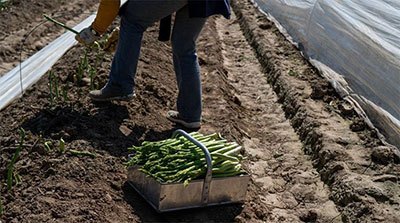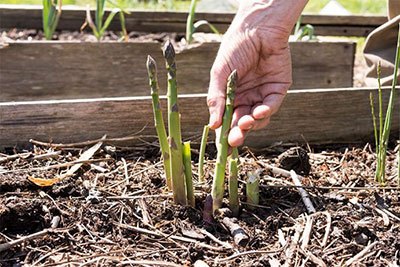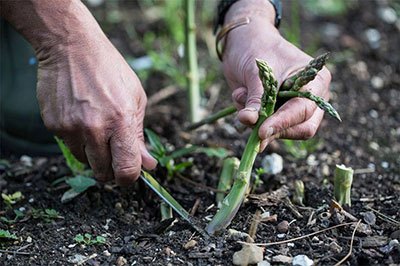When you plant fruits and vegetables, you’re mostly going to transplant and transfer them to another location at one point in time. This is especially true for spring vegetables such as asparagus.
Transplanting asparagus is important because it is required of them to be transferred to a different location which is more suitable for their specific stage of growth.
In this article, we’re going to talk about just that and teach you the right way how to transplant asparagus.
Table of Contents
What you will need
1. Asparagus

The first and most obvious thing you’re going to need is asparagus. Before you do the actual transplanting, you first need to, of course, plant it on the ground.
When you’re still choosing the asparagus seed you’re going to plant, see to it that it is fresh and it doesn’t have any form of defect or discoloration.
When you’ve already planted it, the perfect time to then transplant it is in early spring. This is the time when your newly planted asparagus has just started waking up.
2. Spade fork
You need to have a spade fork when transplanting asparagus. This is because a spading fork is an ideal piece of equipment for transplanting plants due to its thin and durable thines.
The thines are very useful when it comes to precise gardening because they wouldn’t damage the surrounding parts of the plant.
It’s also an effective tool for loosening up the soil and lifting and turning the soil over to the ground.
3. Shovel
You also need to prepare a shovel because you’re going to use this in digging up a pit where you’re going to transfer your asparagus. You don’t need to have a huge and heavy-duty shovel because you’re only going to dig up loose loam soil.
The lighter the shovel, the better it is. It’s because you’ll be faster in digging the soil up. Remember, you’re just going to dig up a shallow pit. You don’t need to put a serious amount of effort into it.
4. Compost

This is another essential must-have because your asparagus’ survivability would surely hang in the balance if you don’t put compost in the place where you’re going to transplant it to.
You can have different kinds of compost, be it synthetic or organic. It could either be manure, fertilizer, or a commercial product. It would also be best if you pair the compost with an anti-molding substance or perhaps a pesticide to avoid mold growth and pest infestations.
5. Water
These asparagus plants need a lot of water because these are spring vegetables. They can easily dry up if they don’t get enough water throughout the day.
See to it that the place where you’re going to transplant your asparagus into isn’t directly exposed to sunlight because that will surely lead to your asparagus drying up and eventually dying.
It’s highly recommended that you water your asparagus three times a day. The first watering session would be before sunrise, then at noon, and then at sunset.
It would also be better if you have your sprinkler system or soaker hose installed in your garden. This way, you’re making sure that the water would directly go into the roots.
Knowing the process
1. Untangle the roots using your spade fork
The first thing you need to do in transplanting your asparagus is to locate the place and estimate where most of the roots are.
In doing this, you’re going to need a spade form to locate the exact location of its roots. Most probably, the roots are entangled. Use the spade fork to untangle them carefully.
2. Lift the crown and trim the roots

Lift the crown and trim the roots gently and divide them using your spade fork. You can also use your hands to make the dividing process more precise.
Then slowly start lifting its crown. You then carefully trim the roots with a pruner or gardening scissors.
Be sure that you won’t end up cutting its base because it still needs to re-grow some parts later on.
3. Prepare the trench
Then start digging a trench that is deep enough to accommodate the asparagus’ complex root system. The depth depends on the complexity of its roots. It can range from three feet deep to even more than three meters deep.
Place the compost at the bottom of the pit and mound up a little bit of soil on the compost to solidify it.
Gently position the crown of the asparagus on the mound of soil, having the roots scatter throughout its sides. Evenly spread the roots.
4. Transplanting and mounding it up
Use your shovel in piling up the soil back on your dug-up trench. Then water it so that the soil would harden.
You can then put mulch on it to act as protection from external factors that might cause negative effects on your newly transplanted asparagus.
Remember that these are very fragile, which is why you need to keep a close eye on them in the first few days after they were transplanted.
Conclusion
With all of these being said, you can see that transplanting asparagus is not that hard to do. You just need to have the needed technical know-how, the determination, and the right tools and methods.
With the help of this article, there’s no doubt that you can do the transplanting process yourself the right way. Asparagus has a lot of nutritional benefits, apart from it being an important food ingredient. For sure, you’ll be growing asparagus in your backyard or garden in no time.
If you like this article, feel free to share it with your family and friends to that they’ll also learn from it. If you have any opinions or thoughts about the subject matter, you can share them with us by writing in the comment section below.
We would love to hear from you guys.

I LIVE IN THE NORTHWEST. I DISCOVERED I HAD VOLES IN MY ASPARAGUS BED. THE BEDS ARE 14 YEARS OLD. I HAVE A LOT OF SKINNY ASPARAGUS AND ABOUT 25 PERCENT BIGGER. I THINK MAYBE THE VOLES ATE SOME CROWNS.
I WOULD LIKE TO REPLANT INTO A RAISED BED. I WOULD LIKE TO DO IT AFTER THIS YEARS HARVEST. THE SKINNY ASPARAGUS HAS BEEN FERNING OUT SINCE THE BEGINNING. IS IT POSSIBLE TO TRANSPLANT AFTER HARVEST? CAN I CUT THE FERNS (I NORMALLY LEAVE THEM UNTIL THE FOLLOWING SPRING OR UNTIL THEY TURN BROWN)? ALSO READ SOMETHING ABOUT REMOVING ANY FERNS WITH SEEDS. IS IT TRUE? IS IT POSSIBLE THE SEEDS THAT DROPPED ARE CROWDING OUT OLDER CROWNS?